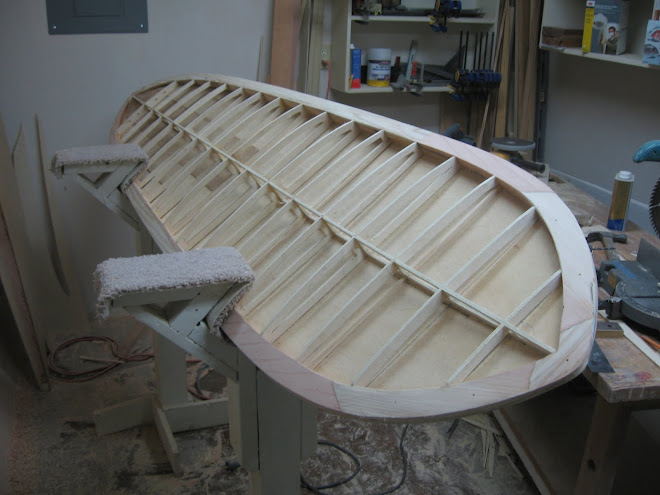
This blog is an offshoot of my
"retro-surfer" blog, about my venturing back into the lineup after many years away.
In late summer of '09 I got back into surfing - after a 23 year hiatus! My first new board at that

point was a retro fish I bought for $300 on ebay, and I was disappointed to find it, and all the boards in the warehouse/showroom where I picked it up, were made in a Chinese factory by workers who didn't surf. I still remember the time when surfboards were built and sold by surfers! Despite the nice Chinese sales girl I spoke with, I had visions of a child-labor sweatshop back in her homeland.
So I decided to look into the possibility of building my own surfboard. I did some research on internet, and discovered there were kits and plans available. But some were pricey, and most I didn't really like the shape.
I decided to design my own, based on my foam retro-fish, and build it from scratch, using as much wood from my inventory as possible. My system is original, its "rails-first", meaning the rails are the first thing built and then the board structure is added. I call it "bahrman rails", and I'm in the middle of building my third board with this system.
I found an internet forum,
tree-to-sea*, about hollow wooden surfboards. I joined, and began asking questions. Most hollow wooden surfboards are built around a model-airplane wing type structure, and I had a lot of experience building model airplanes as a kid.
* the original tree-to-sea site has been largely abandoned, although it is still there. The site has moved to a
new web location, with lots of buttons, bells, and whistles, that I find confusing to negiotiate. Hence, I also set up an
"alternative surfcraft" forum, with the hopes that others who desired a simple straightforward forum might gravitate there to share, learn, and teach.












 point was a retro fish I bought for $300 on ebay, and I was disappointed to find it, and all the boards in the warehouse/showroom where I picked it up, were made in a Chinese factory by workers who didn't surf. I still remember the time when surfboards were built and sold by surfers! Despite the nice Chinese sales girl I spoke with, I had visions of a child-labor sweatshop back in her homeland.
point was a retro fish I bought for $300 on ebay, and I was disappointed to find it, and all the boards in the warehouse/showroom where I picked it up, were made in a Chinese factory by workers who didn't surf. I still remember the time when surfboards were built and sold by surfers! Despite the nice Chinese sales girl I spoke with, I had visions of a child-labor sweatshop back in her homeland.